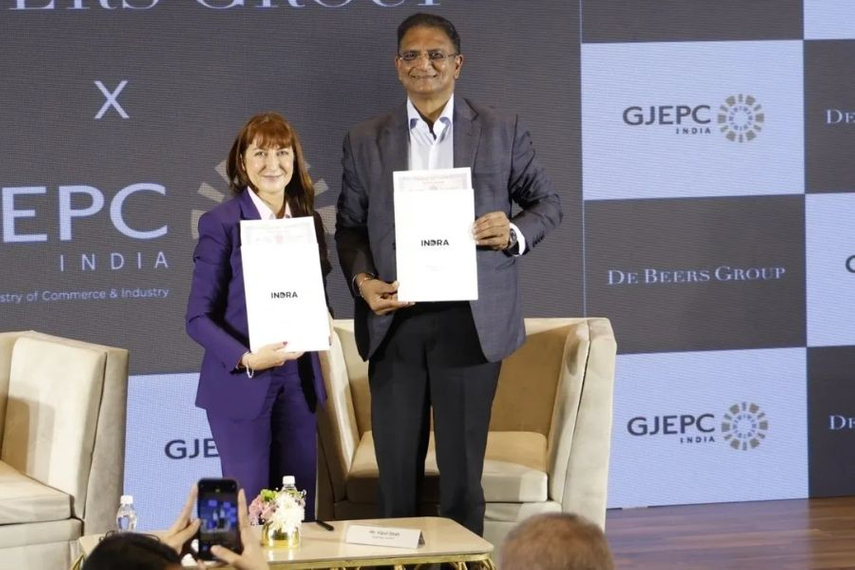
Global diamond company De Beers Group has joined hands with the Gem & Jewellery Export Promotion Council (GJEPC), India’s jewellery trade body, to launch the Indian Natural Diamond Retailer Alliance (INDRA). This initiative is an effort to preserve and grow the market share of natural diamonds in India.
The programme seeks to equip independent retailers with technology tools and training to strengthen the natural diamond narrative amid stiff competition from lab-grown diamonds (LGDs).
The collaboration will roll out customisable marketing assets, AI-driven campaigns, and multi-lingual training modules to help retailers better engage with consumers. These offerings are tailored to India's diverse and evolving jewellery market, which includes bridal, everyday wear, and entry-level diamond pieces. Starting January 2025, interactive roadshows will provide GJEPC members the opportunity to enrol in the programme.
India's diamond market, currently valued at $85 billion, is projected to grow to $130 billion by 2030, according to GJEPC chairman Vipul Shah. Yet the industry is grappling with significant headwinds. Natural diamond exports have slumped, primarily due to weakened demand in key markets like the US and China, coupled with the rising popularity of LGDs.
Shah underlined the importance of INDRA, noting, “This initiative reflects a shared vision to educate stakeholders, empower retailers, and boost consumer demand, all while highlighting the timeless value of natural diamonds.”
De Beers Brands CEO Sandrine Conseiller echoed this sentiment, pointing out that natural diamond penetration in India’s jewellery market is a mere 10%, far below that of mature markets such as the US. She emphasised the untapped potential of India’s growing economy and young demographic, stating, “This collaboration with GJEPC will help unlock opportunities for increased consumer demand across all segments of natural diamond jewellery.”
The rise of LGDs, which offer affordability and perceived ethical advantages, has emerged as a key disruptor in the global diamond market. They have gained significant traction among price-sensitive and environmentally conscious consumers. In India, this shift has contributed to a projected 25% to 27% drop in revenues for the natural diamond polishing industry, with total revenues hitting a decade-low of $12 billion this fiscal.
The impact of LGDs extends beyond pricing pressure. Consumer confusion between natural and lab-grown diamonds has muddied the waters, exacerbated by inconsistent labelling and marketing practices. The GJEPC is now advocating for amendments to India’s Consumer Protection Act to enforce clear distinctions between the two, aligning with updated guidelines from the US Federal Trade Commission (FTC).
INDRA aims to address these challenges head-on by equipping retailers with tools to create a compelling case for natural diamonds. Through AI-driven campaigns, storytelling initiatives, and in-depth training, the programme seeks to educate both consumers and industry stakeholders. Retailers will gain access to market intelligence portals and resources to craft impactful, locally relevant narratives that resonate with India’s diverse consumer base.
As India’s festive season approached last year, the Natural Diamond Council (NDC) launched its campaign, 'Make Sure It’s a Natural Diamond', urging consumers to choose authentic, natural diamonds. It featured globally recognised icons like the Taj Mahal, Banarasi sarees, Pashmina, wine, and natural diamonds to convey that 'Precious things are crafted'.
Amit Pratihari, managing director of De Beers India, emphasised the appeal of natural diamonds, stating, “Natural diamonds have emerged as the preferred choice for consumers, valued for their preciousness and enduring significance.” He added that India’s diamond market is poised for growth, driven by rising disposable incomes, urbanisation, and e-commerce, as “the emotional value of natural, responsibly sourced diamonds remains unmatched.”

The NDC noted that its communication targets consumers who view natural diamonds as symbols of eternal love, togetherness, and commitment, celebrating life’s most meaningful moments. It described natural mined diamonds as “unique, timeless, real, rare, invaluable and precious” – akin to the emotions they represent.
Moreover, the collaboration between GJEPC and De Beers leverages the former's network of over 10,500 members and De Beers’ expertise in diamond marketing. Together, they hope to elevate the value proposition of natural diamonds, differentiating them from their lab-grown counterparts.
Beyond LGDs, the diamond industry faces broader challenges, including a trend towards experiential spending over material possessions and fluctuating diamond prices due to oversupply. These factors have dampened consumer confidence in natural diamonds. Additionally, demand for gold jewellery is on the rise, particularly in China, which accounts for 28% of India’s diamond exports.
De Beers and GJEPC are banking on India’s growing middle class and rising disposable incomes to revitalise natural diamond sales. However, with US demand down by 43% over the past two fiscals and China showing a preference for gold, the path to recovery is far from straightforward.
One of the more subtle challenges lies in the ethical narrative surrounding natural diamonds. LGDs are often marketed as a sustainable alternative, raising questions about mining practices and their environmental impact. INDRA’s success will hinge not only on its ability to boost demand but also on addressing these ethical concerns with transparency and clarity.
GJEPC's Shah emphasised the importance of consumer education, stating, “This will ensure all key stakeholders in the trade value chain are responsible and empowered to guide, counsel, and advise consumers to enhance confidence.” However, critics argue that simply promoting natural diamonds without addressing the underlying ethical debates may not be enough to sway sceptical consumers.
INDRA’s emphasis on innovative marketing and retailer empowerment signals a proactive approach to the challenges facing natural diamonds. By bridging the gap between traditional practices and modern consumer expectations, the collaboration has the potential to reinvigorate the industry. However, its long-term success will depend on how effectively it can differentiate natural diamonds in a market increasingly crowded by lab-grown alternatives.
As India cements its position as the world’s fastest-growing diamond jewellery market, the stakes are high. De Beers and GJEPC’s partnership may provide a blueprint for navigating these turbulent times, but the road ahead remains uncertain. For industry professionals, the initiative serves as a case study in adapting to shifting consumer behaviours while maintaining the appeal of a legacy product.


.jpg&h=334&w=500&q=100&v=20250320&c=1)
.jpg&h=334&w=500&q=100&v=20250320&c=1)
.jpg&h=334&w=500&q=100&v=20250320&c=1)


.jpg&h=334&w=500&q=100&v=20250320&c=1)





_20230119024400.png&h=268&w=401&q=100&v=20250320&c=1)


.jpg&h=268&w=401&q=100&v=20250320&c=1)
.jpg&h=268&w=401&q=100&v=20250320&c=1)


